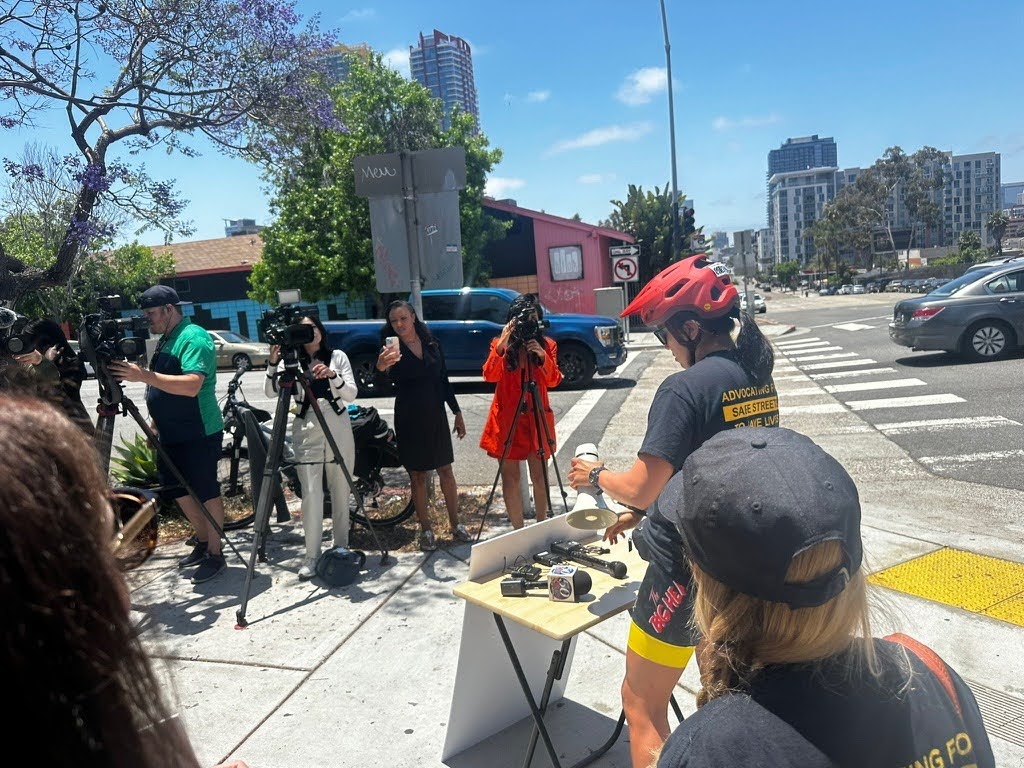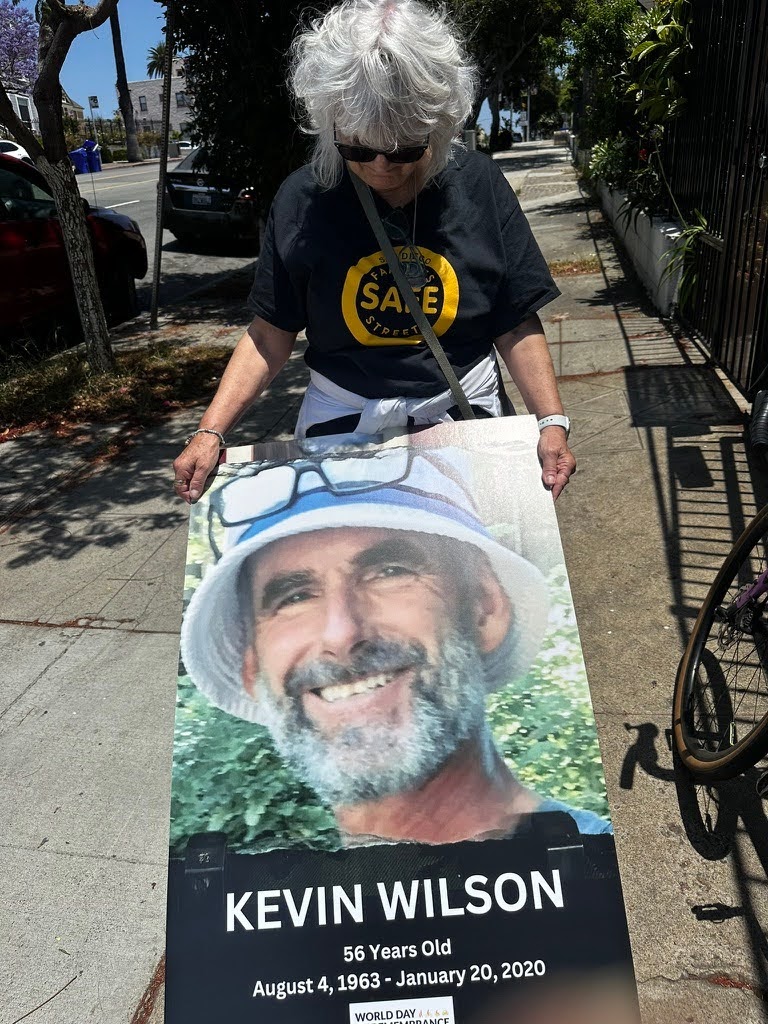By Chris Roberts, Transportation Team Leader Co-lead, SanDiego350
Also published on The Jumping Off Place

On May 31, 2024, a remarkable rally was held at one of San Diego’s most dangerous intersections for pedestrians and bicyclists: Market and 19th Street in Sherman Heights. At that intersection, in 2020, Jason Gordon was crossing the street when he was struck and killed by a hit-and-run driver. He left behind his wife Katie and his two one-year-old daughters. The protest, called “Fix the Fatal 15”, was organized by Circulate San Diego, Families for Safe Streets San Diego (FSSSD), BikeSD, and San Diego County Bike Coalition to draw attention to the fact that the 2024/25 budget proposed by Mayor Todd Gloria only contained funding for making necessary safety fixes to 8 of the 15 most dangerous intersections in San Diego.
The Fatal 15 intersections were defined as having the highest rates of death of pedestrians and cyclists over the past several years. The protest was attended by multiple media outlets, including KPBS, CBS and Fox, which carried news segments covering the rally, with interviews from several members of FSSSD.
Circulate San Diego proposed the first list of Fatal 15 intersections in 2017, to focus attention on a manageable number of very dangerous intersections, which could be significantly improved at relatively low cost. Repairs to these intersections were completed in 2019/20. The repairs included basic improvements to the intersections, including:
1) Stripes: White “Zebra” stripes at Crosswalks that are maintained so that they are easily seen by both pedestrians and motorists.
2) Signals: Classic “Walk/Don’t Walk” flashing signals.
3) Sounds: Clearly audible voice commands alerting people that it’s safe to cross.

In spite of these and other repairs to our streets, the number of fatalities for pedestrians and bicyclists has remained stubbornly high. So, in early May 2024, Circulate San Diego published a new Fatal 15 intersections list, and held a press conference to make the announcement. The Fix the Fatal 15 protest held on May 31 was a reaction to the failure of the Mayor’s budget to fund fixes to all of the intersections.
The mood at the rally was very somber, because FSSSD displayed large posters showing beautiful photos of loved ones who were killed by cars while walking or bicycling on our streets. Several members of FSSSD gave speeches, including Laura Keenan (co-founder of FSSSD), whose husband Matt was killed while bicycling to the movies in 2021 in Mission Valley. It was incredibly moving to listen to the speeches, while other protesters held up posters of loved ones killed on our streets.
After the speeches, we marched the crosswalks of Market and 19th, shouting “What do we want? Safe streets! When do we want it? Now!” The intersection lived up to its billing as one of the most dangerous intersections, because 1) there was a lot of traffic, 2) there weren’t Walk/Don’t Walk flashing lights at each corner, 3) the crosswalk stripes were worn away so not clearly marked for drivers, and 4) many drivers wouldn’t look up from their phones. It was actually difficult to know when to cross the street! This is completely unacceptable. Our city shouldn’t have such dangerous intersections.
Why is this important to SanDiego350?
A primary goal of SanDiego350 is to mitigate the worst effects of climate change and injustice through advocating for reduction of greenhouse gas emissions (GHGe). The SD350 Transportation Team is actively working to promote alternative modes of transportation to passenger vehicles, which are the single largest contributor to GHGe in California. Walking and bicycling should be acceptable alternatives to driving a car, as they require essentially zero fossil fuels and have positive health benefits. However, the fact that the streets in San Diego are so unsafe is a significant impediment to getting more people to choose walking or bicycling to work (assuming they live close enough that this is a reasonable commuting option). This is also a significant social justice issue, as Black and Hispanic pedestrians and bicyclists are killed at significantly higher rates than white people, and most of the Fatal 15 intersections are in under-served neighborhoods that are predominantly black and hispanic.
A Happy Ending!
On June 10, the San Diego City Council announced that the revised 2024/25 budget earmarks $785,000 to fix the remaining seven deadly intersections, so that all of the Fatal 15 intersections will be fixed to improve safety. Council President Sean Elo-Rivera said, “We’ve heard from spouses who’ve lost the loves of their lives to unnecessary traffic violence. We’ve heard from all parts of the city and all walks of life, and I think the common thread is love for community, love for their city and a deep belief that things can and should be better.” This is a great example of how direct action by advocacy groups, when targeted in an effective way, can have a significant impact.
What should we do going forward?
First of all, on an individual level, we should all strive to be safer drivers. Drive very close to or below the speed limit. We all know that this is much safer, and reduces GHG emissions. In fact, as little as 5 mph slower can be the difference between life and death. Stop and look carefully before moving through intersections. Ask yourself, am I really in that much of a hurry that I need to exceed the speed limit? Just because many other cars on the highway are driving excessively fast, do I need to do the same? And perhaps most importantly, put down the phone when driving. Install a phone mount on the dashboard so that you can follow directions in a hands-free manner. Pay attention to the road!
At a higher level, there needs to be effective, actionable plans in place on how our streets and highways can be made safer. Vision Zero San Diego was established as a goal in 2015, but our efforts have clearly been inadequate, as traffic deaths have remained at record levels. It shouldn’t require grass-roots efforts by groups like Circulate San Diego and FSSSD to demand that deadly intersections be repaired. There should be long term plans in place for these needed upgrades, and the funding to make it happen.
Thank you to Laura Keenan for valuable edits to this article.
